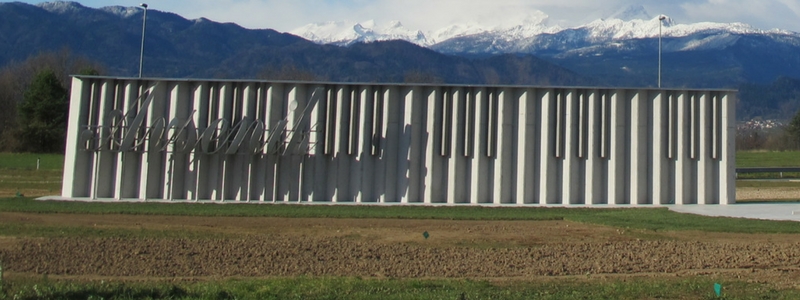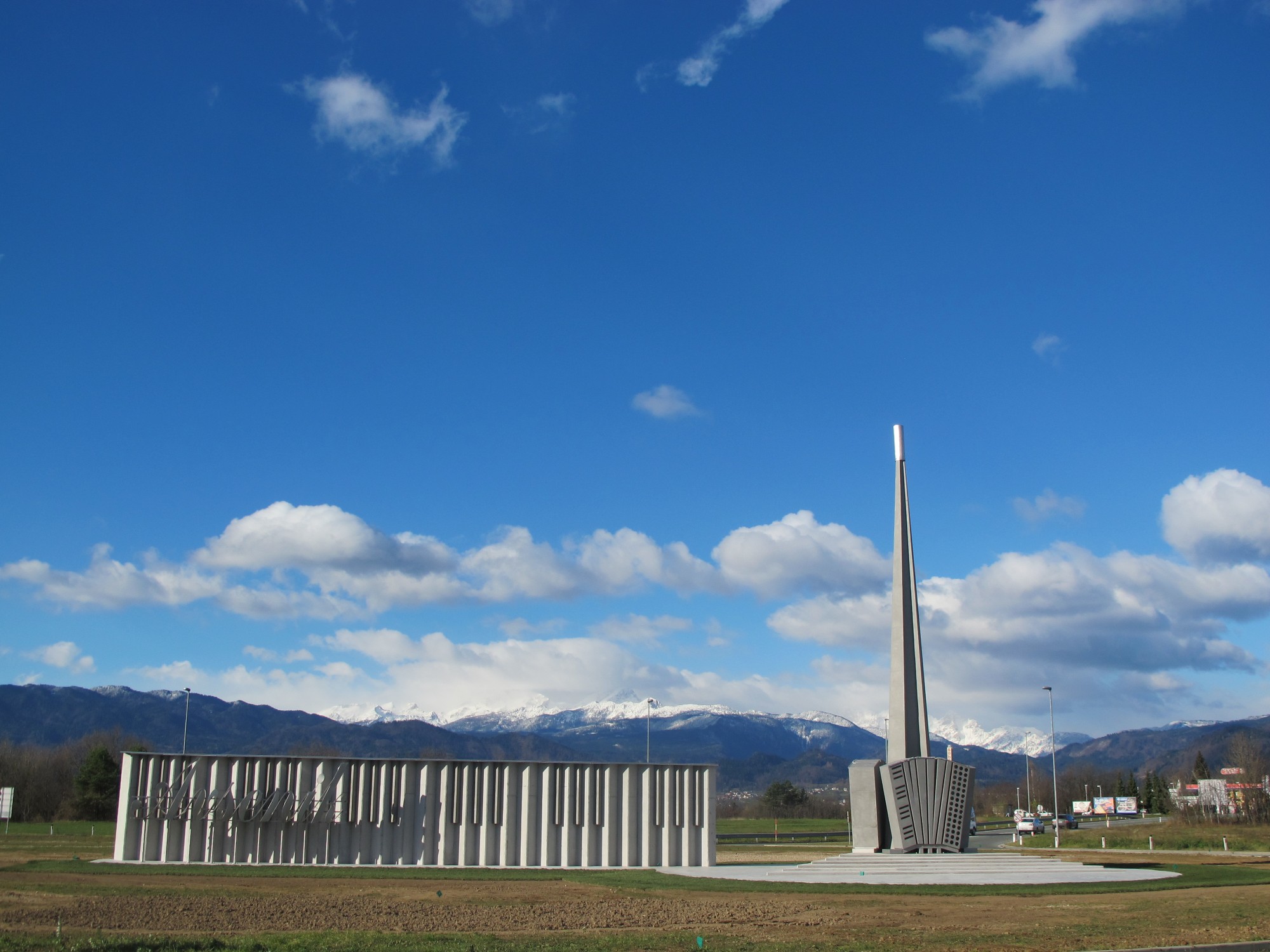In 2013, marking the 84th birthday of Slavko Avsenik and the 60th anniversary of the Avsenik Brothers’ life in music, a sculpture was unveiled on the roundabout on the motorway interchange near Lesce. Erected by the Municipality of Radovljica, the monument is dedicated to the pop-folk music of the Avsenik Brothers Ensemble. A keyboard, three accordions and a 16-metre-high traditional Upper Carniolan umbrella honour the legacy of the Avsenik Brothers, who originate from the region situated at the foot of Mount Triglav and the Karavanke Mountains.
The work, by architect Klemen Rodman, attracted not only praise, but also criticism from some observers who noticed inconsistencies in the succession of the keyboard’s white and black keys.
Avsenik Brothers Ensemble
The Avsenik Brothers were the most prominent pop-folk music figures in Slovenia and Europe. Slavko Avsenik (1929–2015), together with his brother Vilko Ovsenik (1928–2017) (who adopted the old, pre-war spelling of his surname) and their legendary ensemble, was instrumental in shaping both the sound of, and style of costume associated with, this genre. The influence of Avsenik’s innovative style spread beyond Slovenia’s borders, extending to Germany, Austria, Switzerland and the Benelux Countries, where hundreds of similar folk-pop orchestras were modelled after the Ansambel bratov Avsenik (The Avsenik Brothers Ensemble or, in German, Slavko Avsenik und seine Original Oberkrainer). Under their influence, a music genre known as the Cleveland-style polka, developed by Slovenian immigrants, took off in the US.
The saga of the Avsenik Brothers, which assumed the proportions of a worldwide phenomenon, began in their native town of Begunje na Gorenjskem. A self-taught musician, Slavko learnt to play the piano accordion by ear, while his brother Vilko, studying clarinet at the Ljubljana Academy of Music, obtained a university education. Slavko first appeared on Radio Ljubljana in 1953 and was broadcast from Austria on the Slovenian Hour radio show. He gradually formulated his ensemble line-up, which initially included a guitar and double bass as well as accordion.
He was later joined by his brother Vilko on clarinet. Vilko attended to the arrangements and recruited additional members, singers and instrumentalists: trumpeter Franc Košir, baritone Franc Ogrizek and singers Danica Filiplič and Franci Koren. Vilko came up with the characteristic line-up – consisting of accordion, trumpet, baritone, clarinet and guitar, which invested the ensemble’s sound with a unique pop-folk quality. Growing in popularity, their fame spread from Austria to Germany, where the ensemble appeared in numerous broadcasts, films and concerts.
Signing a recording contract with Teldec (Telefunken-Decca) in 1960, the ensemble solidified their reputation and rose to dizzying heights throughout Europe. The landmarks of the ensemble’s career include a performance at the Berlin Stadium before an audience of 80,000 and at the Berlin Philharmonic, tours of the US and Canada and a one-hour ZDF German network special in 1980. The ensemble’s style of music and costume was influenced by different ensemble members, singers and instrumentalists, including Alfi Nipič, Franc Košir, Mik Soss, Ema Prodnik, Franc Koren and Lev Ponikvar. Lyricists and acknowledged poets Ferry Souvan, Gregor Strniša and Frane Milčinski-Ježek wrote the ensemble’s lyrics.
Avsenik’s influence extended as far as North America. In 1958, Johnny Pecon’s adaptation of Slavko’s Tam, kjer murke cveto (Where the Wild Orchids Bloom) generated an all-time-favourite Cleveland-style hit, Little Fella. Avsenik’s wealth of compositions, alongside those by Matt Hoyer and Dr. William J. Lausch-Doc and Frankie Yankovic – ranks him among the leading representatives of the Cleveland-style repertoire.
One of Slovenia’s most popular music orchestras, the Avsenik Brothers Ensemble spawned a series of similar line-ups. With record sales amounting to 32 million units, the ensemble were awarded thirty-one gold records, and two diamond and one platinum.
Avsenik’s most famous waltzes include Pastirček (The Little Shepherd), Slovenija, od kod lepote tvoje (Slovenia, wherefrom Your Beauties), Veter nosi pesem mojo (The Wind Carries My Song), Prelepa Gorenjska (The Beautiful Gorenjska) and Tudi ti nekoč boš mamica postala (You Too Shall Be a Mother One Day). The Avsenik Brothers’ signature tune and most popular composition is the polka Na Golici (Trompeten-Echo in German, Trumpet Echoes in English), which is considered to be the world’s most played instrumental composition in the genre.
What generated the formation of countless similar orchestras in Slovenia and internationally, besides the characteristic sound and melodiousness of the ensemble’s original songs, were the band’s vividly coloured and conspicuous stage costumes. This unique outfit first emerged with folk musicians in the bourgeois milieu of Gorenjska (Upper Carniola). Initially wearing an attire resembling that of folk musicians, the Ansambel bratov Avsenik later added more glitter and glamour to a partly stylised national costume, thus creating a stage identity that became a synonym for pop-folk music, popularly known abroad as the “Oberkrainer” style.
Maia Juvanc

